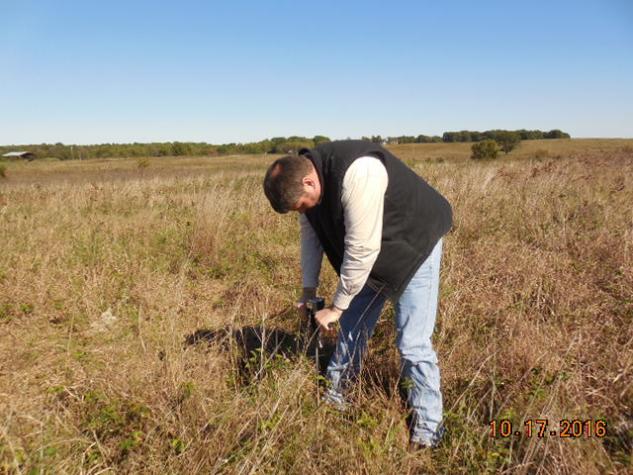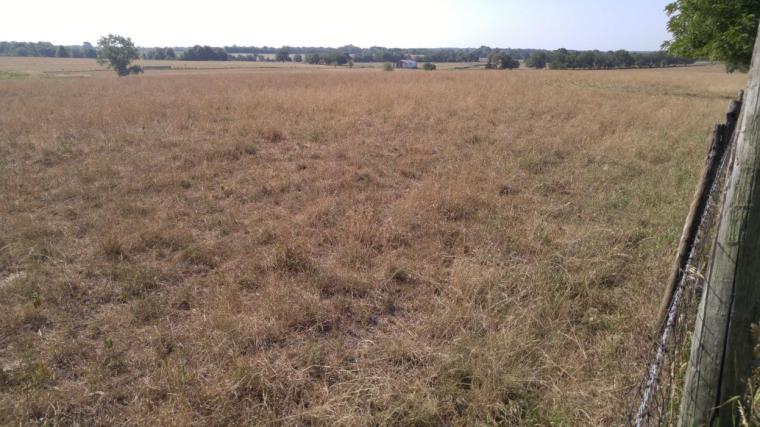A No. 2 pencil is a beef producer's best tool
COLUMBIA, Mo. – One of the most important tools for livestock producers is a sharp No. 2 pencil. The pencil and some basic arithmetic can help take the emotion out of desperate measures to find feed. When you do the math, buying grain or other alternative feeds may be the best bang for the buck, says University of Missouri Extension agricultural business specialist Wesley Tucker.
Early weaning calves to reduce nutrient needs during drought
STOCKTON, Mo. – “Early wean calves to reduce cow herd nutrient needs to match drought-limited feed resources,” says Patrick Davis, University of Missouri Extension livestock field specialist. In addition, early weaning can improve calf performance because calves are put on a more nutritious diet following weaning.Davis discusses strategies to help cattle producers be successful in early weaning calves:
Things to consider as you feed your way through the drought
“Cattle producers are dealing with varying degrees of drought and forage resources,” says Patrick Davis MU Extension livestock field specialist. Some cattle producers have received adequate rain and are recovering from the 2022 drought through rebuilding forage and cattle resources. Other cattle producers have received limited rain and are continuing to deal with drought conditions from 2022 with less resources in 2023.
Use spray-wait-spray to renovate drought-stricken pastures
Learn how the spray-wait-spray method can renovate drought-hit pastures with nontoxic fescue efficiently.
MU Extension specialists report thin pasture stands, low yields
Dry conditions are causing thin pastures and low hay yields across Missouri, stressing farmers and livestock producers this spring.

Save money on fertilizer with soil tests
Learn how soil testing can help farmers apply fertilizer more precisely, cut costs and protect the environment.
MU agronomist gives post-drought pasture renovation tips
Learn effective strategies for renovating drought-affected pastures, including no-till drilling, emergency forage options, and long-term forage solutions.
Proper hay storage, feeding methods reduce waste
CLEVER, Mo. –Due to poor storage and feeding methods, only about half of Missouri hay reaches the cow’s mouth, says University of Missouri Extension livestock specialist Andy McCorkill. This leads to waste and reduced profits, especially as producers reset their herds post-drought. “Make sure your high-value hay gets in the mouth of an animal,” says McCorkill.
'Sacrifice pastures' spare best cattle grazing pastures
STOCKTON, Mo. – So-called “sacrifice pastures” might be needed to help promote forage production the rest of this cattle grazing season, according to Patrick Davis, a University of Missouri Extension livestock specialist based in Stockton. “Cattle producers welcome the rain, but it leads to muddy pastures, and with limited forage resources following the drought, proper management is needed for optimum grazing the rest of the year,”…
Be ready to manage spring flush
COLUMBIA, Mo. – Get a head start on pastures for the year with good management of spring flush, says University of Missouri Extension state forage specialist Harley Naumann.Early decisions determine pasture health for the rest of the season, Naumann says.
Registration open for fescue workshop
Register for a March workshop on renovating toxic tall fescue pastures and integrating improved varieties into grazing systems.
Workshop tells how and why to renovate tall fescue pastures
COLUMBIA, Mo. – Forage and beef producers can learn from world-renowned forage experts the how and why of renovating toxic tall fescue pastures at a March 23 workshop in Mount Vernon, Missouri.
Forage expert gives 4 top reasons to frost seed legumes
Frost seeding legumes boosts pasture yield, cattle health, and reduces fertilizer costs in Missouri fields.
Boost profits by frost seeding legumes now
Frost seed legumes in cool-season pastures to boost cattle weight and profits while improving pasture health.

Winter is time to plan to beat the Summer Slump
KIRKSVILLE, Mo. – Winter is the time for livestock producers to prepare pastures for drought, says University of Missouri Extension state forage specialist Harley Naumann. Drought is now the rule rather than the exception in Missouri, Naumann says. According to the U.S. Drought Monitor, somewhere in the state experienced drought every year but one since 2000.
How you feed hay this winter is more important than ever
GALENA, Mo. – With a shortage of standing forage for cattle and the low availability of hay, it is more important than ever this winter to reduce waste when feeding hay.Hay waste is normal, but it can be controlled and minimized, said University of Missouri Extension agronomy specialist Tim Schnakenberg.
Pastures, goats benefit from grazing an invasive species
Goats grazing on invasive sericea lespedeza improve pasture quality and gain natural anti-parasitic benefits, according to University of Missouri research.
MU videos share cattle management practices in drought
COLUMBIA, Mo. – Drought continues to plague growers and livestock producers in parts of Missouri, especially in the southwest corner of the state, raising concerns about feed availability.“It’s a perfect storm of high fertilizer prices, reduced fertilization of pastures lending to lower hay yields and drought in the southern half of Missouri,” said Eric Bailey, University of Missouri Extension state beef specialist. “Folks are eating…
